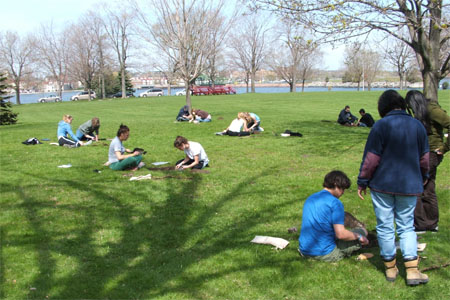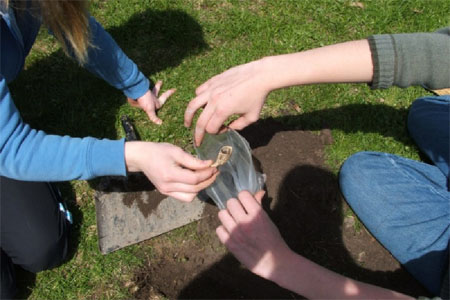This year the “Can You Dig It?”© Summer Archaeology Program teamed up with Queen’s University E=MC2 enrichment mini-course to excavate the Naval Cottages and Naval Hospital on Point Frederick at the Royal Military College of Canada. The 42 participants of the “Can You Dig It?”© field school excavated the Naval Cottages. While the crew of 21 from Queen’s University E=MC2 enrichment mini-course excavated at the Naval Hospital.
One of the objectives of this year’s field school was to determine whether or not the current residence of the Commandant of RMC was the Naval Hospital. Locating a section of hospital foundation wall on the lawn area northwest of the Residence was a key find. This find associated with artifacts found from the period of use of the hospital between c.1813 and 1840s, confirm that the current residence of the Commandant of RMC is not, as has traditionally been accepted, the Naval Hospital.
As for the Naval Cottages, previous excavations had focused only on the southerly cottages, which were destroyed by the 1868 fire, this year’s excavations focused on both southerly and northerly cottages. In the north area where the cottages remained in use until torn down in 1910, the most surprising discovery was the existence of native pottery. This clearly signifies that the point was in use long before the French and British came to the area. Another unexpected find was the possible shanty foundation wall in the southerly area. This feature predates the construction of the Naval Cottages and is most likely associated with the War of 1812 shanties that the shipwrights built and lived in.
 Although the Naval establishment on Point Frederick began at the latter end of the 18th century, it is not until the War of 1812 and the arrival of the Royal Navy in 1813 that the facility starts to see drastic changes. And at some point between June 1813 and 1814 the Naval Hospital on Point Frederick was erected. The entire range of cottages was in existence from 1822 until 1868 when a devastating fire destroyed the southerly six and one additional was demolished to create a fire-break. These were completely removed in 1875 when the College was created and the surviving range of nine northerly cottages remained in use until 1910.
Although the Naval establishment on Point Frederick began at the latter end of the 18th century, it is not until the War of 1812 and the arrival of the Royal Navy in 1813 that the facility starts to see drastic changes. And at some point between June 1813 and 1814 the Naval Hospital on Point Frederick was erected. The entire range of cottages was in existence from 1822 until 1868 when a devastating fire destroyed the southerly six and one additional was demolished to create a fire-break. These were completely removed in 1875 when the College was created and the surviving range of nine northerly cottages remained in use until 1910.


 Although the Naval establishment on Point Frederick began at the latter end of the 18th century, it is not until the War of 1812 and the arrival of the Royal Navy in 1813 that the facility starts to see drastic changes. And at some point between June 1813 and 1814 the Naval Hospital on Point Frederick was erected. The entire range of cottages was in existence from 1822 until 1868 when a devastating fire destroyed the southerly six and one additional was demolished to create a fire-break. These were completely removed in 1875 when the College was created and the surviving range of nine northerly cottages remained in use until 1910.
Although the Naval establishment on Point Frederick began at the latter end of the 18th century, it is not until the War of 1812 and the arrival of the Royal Navy in 1813 that the facility starts to see drastic changes. And at some point between June 1813 and 1814 the Naval Hospital on Point Frederick was erected. The entire range of cottages was in existence from 1822 until 1868 when a devastating fire destroyed the southerly six and one additional was demolished to create a fire-break. These were completely removed in 1875 when the College was created and the surviving range of nine northerly cottages remained in use until 1910.